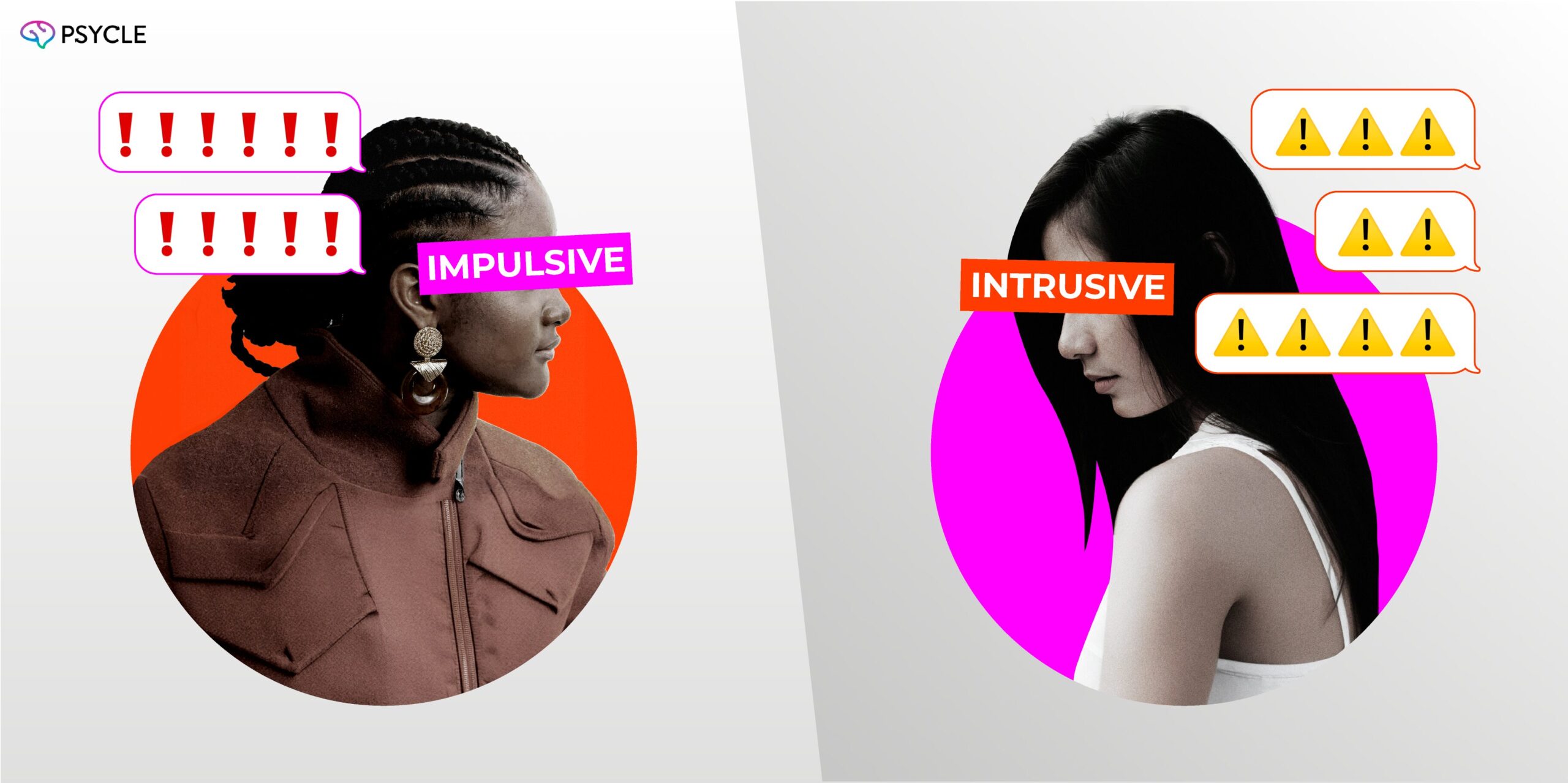Have you ever wondered about the differences between impulsive thoughts and intrusive thoughts and how they can impact our lives? Let’s dive in and better understand what’s the difference between intrusive and impulsive thoughts.
Key Takeaways
- Intrusive thoughts are unwanted, persistent, and disturbing thoughts or images that can cause distress and disruption.
- Impulsive thoughts are action-oriented and often pleasurable thoughts and behaviors that stem from desires and spontaneity.
- Effective coping strategies and therapy can help individuals manage intrusive thoughts and, if necessary, overcome obsessive-compulsive disorder.
- Impulsive thoughts can lead to risky actions and have physical and psychosocial consequences, often associated with drug dependence and certain mental health conditions.
Intrusive vs. Impulsive Thoughts: What’s the Difference?
Intrusive thoughts are unwanted thoughts that creep into an individual’s mind and cause some kind of mental pain. Many a time, these ideas strike the person without prior notice and often pertain to some sort of fear, anxiety, or unacceptable situation that is usually considered complex to dismiss and, hence, a significant cause of stress.
On the other hand, impulsive thoughts are spontaneous and typically result in decision-making or actions carried out in an instant without much thought about the possible outcomes. On average, these thoughts are usually inspired by an urge or impulse to do something at the moment.
While intrusive thoughts have more to do with unwanted and horrifying ideas, impulsive thoughts are those that have relation to actions that occur impulsively, in most cases without rational thinking about them.
Understanding the difference between these forms of thought can help manage them better. Thus, being able to perceive an invasive thought as a fast, uninvited idea and not a reflection of what you want to do could make the resulting reduction less intense. For impulsive thoughts, practicing mindfulness and pause techniques can help prevent rash decisions.
Characteristics of Intrusive and Impulsive Thoughts
Understanding the characteristics of intrusive thoughts versus impulsive thoughts can provide valuable insights into their effects and implications.
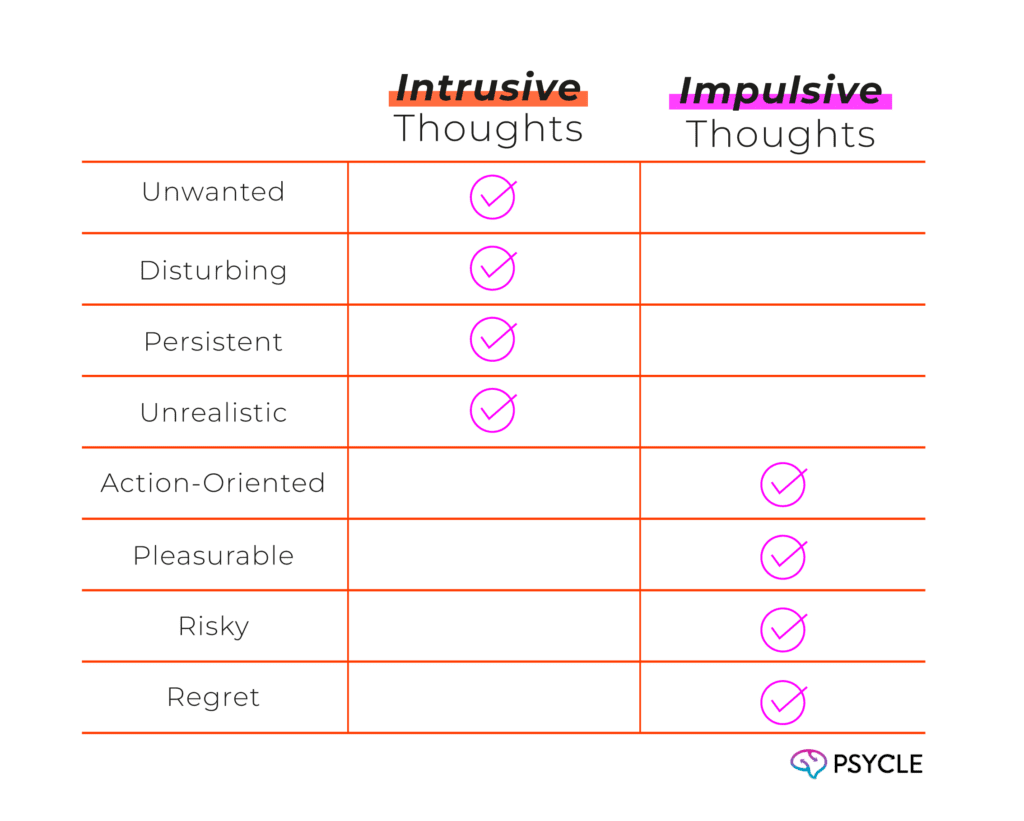

Characteristics of Intrusive Thoughts
Intrusive thoughts often arise in individuals who have experienced anxiety or trauma. These thoughts are unwanted, disturbing, and persistent, constantly intruding upon their consciousness. They can take the form of distressing, violent, or explicit images or ideas, causing significant distress and disruption in daily life.
They can occur in individuals without any mental health conditions, but are especially prevalent in individuals with anxiety disorders and post-traumatic stress disorder (PTSD). Intrusive thoughts are like spam emails for the mind, constantly popping up and demanding attention.
The main characteristics of intrusive thoughts include:
- Unwanted: Intrusive thoughts are intrusive because they are unwanted and involuntary. Individuals often try to suppress or ignore these thoughts, but they can be persistent and intrusive.
- Disturbing: Intrusive thoughts are often disturbing and can evoke strong emotional reactions, such as fear, guilt, or shame.
- Persistent: Intrusive thoughts can persistently recur, making it difficult for individuals to focus on other tasks or thoughts.
- Unrealistic: These thoughts are often unrealistic and not in line with an individual’s true desires or beliefs. They can involve irrational fears or worries.
Intrusive Thoughts Examples
Intrusive thoughts might be of any form and differ significantly from one individual to another. Common examples include:
- Fear of harming others: Worrying you might accidentally hurt someone, but you don’t have any wish or intention to do so.
- Obsessive fears of contamination: Repeated thoughts about germs, dirt, or contamination, leading to compulsive cleaning or avoidance of certain places.
- Relationship OCD: Unwanted doubts about a partner or your feelings, despite an excellent romantic relationship.
- Sexual obsessions: Unwanted sexual thoughts can be disturbing or conflict with your values and beliefs.
- Religious/moral obsessions: Preoccupation with themes about sinning, blasphemous or taboo thoughts, concerns with moral responsibility and purity.
Characteristics of Impulsive Thoughts
Impulsive thoughts stem from desires and spontaneity. They are action-oriented and often associated with seeking immediate gratification or indulging in pleasurable experiences. Impulsive thoughts can manifest as impulsive behaviors, where individuals act without thinking of the consequences.
Impulsive thoughts are like a surge of adrenaline, pushing us to act without thinking.
The main characteristics of impulsive thoughts include:
- Action-oriented: Impulsive thoughts are often focused on immediate actions or behaviors, driven by a desire for instant gratification or to fulfill a spontaneous impulse.
- Pleasurable: Impulsive thoughts are often associated with pleasurable experiences or gratification, leading individuals to engage in impulsive behaviors without considering potential risks or negative outcomes.
- Risky: Impulsive thoughts can lead individuals to engage in risky behaviors or make impulsive decisions without fully considering the consequences or potential harm.
- Regret: Impulsive thoughts may be followed by feelings of regret or remorse as individuals realize the potential negative consequences of their impulsive actions.
Impulsive Thoughts Examples
Impulsive thoughts can lead to spontaneous actions without much consideration for the consequences. Here are some common examples:
- Spontaneous spending: The sudden urge to buy something expensive or unnecessary while shopping, driven by a momentary desire rather than a planned need.
- Blurting out: Saying something inappropriate or hurtful without thinking, often regretting it immediately after.
- Risky behaviors: Engaging in activities like reckless driving, gambling, or extreme sports on a whim, motivated by the thrill or excitement of the moment.
- Emotional eating: Grabbing and consuming a large amount of food quickly when feeling stressed or emotional, without thinking about the health implications.
- Sudden changes in plans: Making abrupt decisions to change plans or routines, such as quitting a job or booking an impromptu trip, driven by a fleeting urge.
Impulsive vs. Compulsive: What’s the Difference?
Impulsive and compulsive behaviors are often confused, but they have distinct differences.
Impulsive behaviors are spontaneous actions taken without forethought, often driven by an urge or desire. Examples include making an unplanned purchase, blurting out something without thinking, or engaging in risky activities.
The key characteristic of impulsive behavior is its sudden and unplanned nature.
Compulsive behaviors, however, are repetitive actions performed to reduce anxiety or prevent a feared event, often as part of a ritual. These behaviors are usually driven by intrusive thoughts.
For example, repeatedly checking if the door is locked, excessive handwashing, or counting objects. Unlike impulsive behaviors, compulsive actions are usually planned and are performed to alleviate distress rather than out of a sudden urge.
Understanding these differences can help to manage and treat the behaviors more effectively. For example, impulsive actions could be reduced through strategies that increase self-control and the capacity for delayed gratification; compulsive behaviors are treated with techniques that address the underlying anxiety and interrupt the learned ritualistic behavior.
Impact of Intrusive and Impulsive Thoughts
Intrusive thoughts can have significant effects on individuals, causing feelings of distress and disruption in daily life. These thoughts are often unwanted, disturbing, and persistent and can create intense emotional experiences.
Despite their distressing nature, it is important to note that the thoughts themselves are similar to those occurring in the general population. This means that experiencing intrusive thoughts does not necessarily indicate the presence of an underlying mental health condition but rather a common experience.
On the other hand, impulsive thoughts can lead to dangerous or harmful behaviors. When individuals act impulsively without considering the potential consequences, it can result in regrettable actions and negative outcomes. These impulsive behaviors may be driven by desires, spontaneity, or a lack of impulse control.
Both intrusive and impulsive thoughts can significantly impact an individual’s daily life, relationships, and overall well-being. Understanding the effects and consequences of these thoughts is crucial in order to develop effective coping strategies and seek appropriate support when needed.
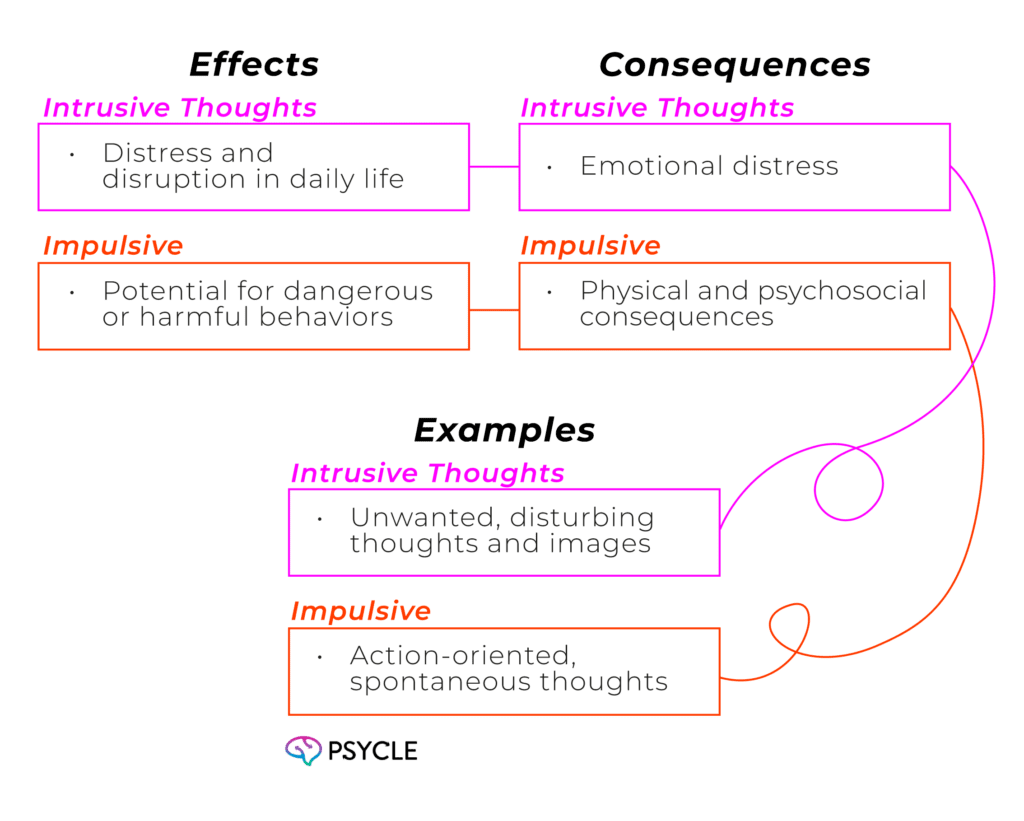

Prevalence of Intrusive and Impulsive Thoughts
Unwanted, intrusive thoughts and impulsive thoughts are common experiences among individuals. These thoughts can significantly impact daily life and mental well-being. Understanding the prevalence of intrusive and impulsive thoughts can help shed light on the frequency of these occurrences.
94% of people experience unwanted, intrusive thoughts and images at some point in their lives. Intrusive thoughts, characterized by their unwanted and disturbing nature, are prevalent among a wide range of individuals. These thoughts often involve distressing content and persistently intrude into one’s mind, causing significant anxiety and disruption.
In contrast, the prevalence of impulsive thoughts is not specified in the available data. Impulsive thoughts can lead to impulsive behaviors, which may have both short-term and long-term consequences.
Coping Strategies for Intrusive Thoughts
While specific coping strategies for impulsive thoughts are not mentioned here, there are various techniques that can help individuals manage both types of thoughts and reduce their impact on daily life. When it comes to coping with intrusive and impulsive thoughts, effective cognitive and behavioral interventions can make a significant difference.
Coping strategies for intrusive thoughts:
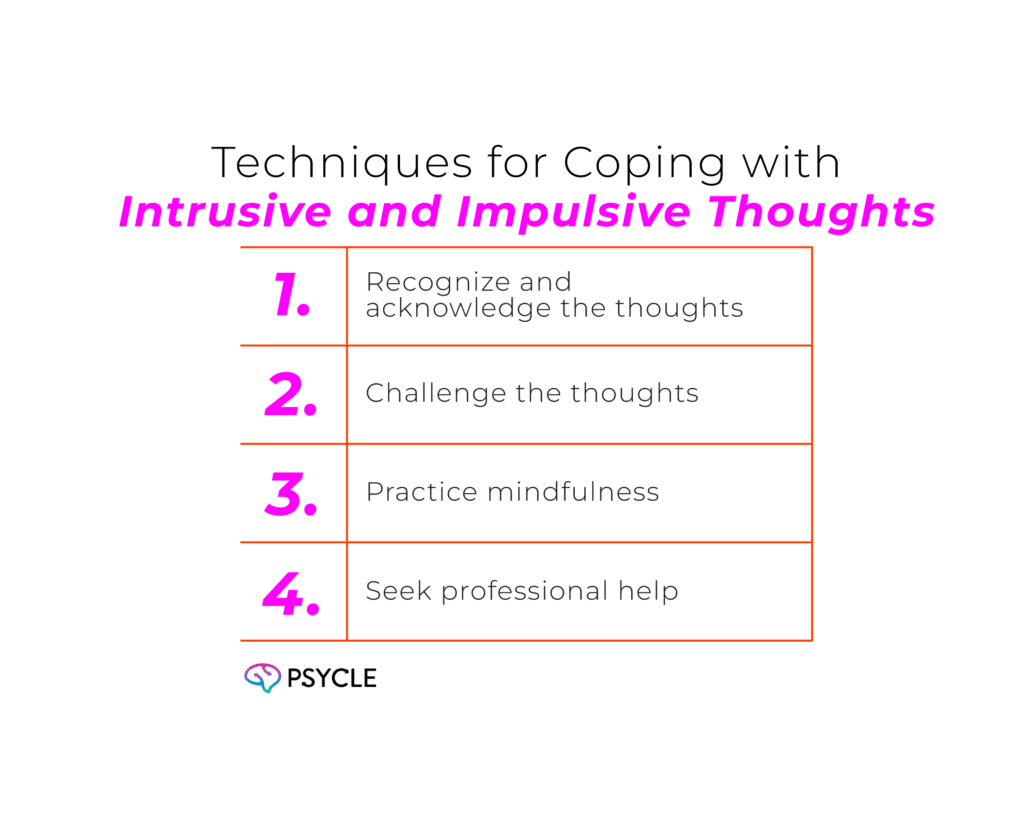

1. Recognize and acknowledge the thoughts:
Start by acknowledging that intrusive thoughts are a normal part of the human experience. Understand that having these thoughts does not make you a bad person and that they do not define you. Recognizing their presence can help you distance yourself from them and prevent them from taking control.
2. Challenge the thoughts:
Question the validity and accuracy of your intrusive thoughts. Ask yourself if there is any real evidence to support them or if they are based on fears, anxieties, or past experiences. Challenging these thoughts can help you gain a more realistic perspective and reduce their impact on your emotions and behaviors.
3. Practice mindfulness:
Mindfulness techniques can be incredibly helpful in managing intrusive and impulsive thoughts. Engage in activities such as meditation, deep breathing exercises, or journaling to stay present in the moment and avoid getting caught up in your thoughts. This can help create a sense of calm and detachment from intrusive and impulsive thinking patterns.
4. Seek professional help:
If intrusive (or impulsive) thoughts are significantly impacting your daily life and functioning, it may be beneficial to seek professional help. Therapies such as Cognitive-Behavioral Therapy (CBT), Exposure and Response Prevention (ERP), and Acceptance and Commitment Therapy (ACT) have been proven effective in managing intrusive thoughts associated with conditions like OCD.
If you want to try therapy, sites like Brightside offer a free mental health assessment. Just complete their 4-minute questionnaire, and you’ll get a personalized treatment plan and an appointment for a virtual session with a professional in less than 48 hours.
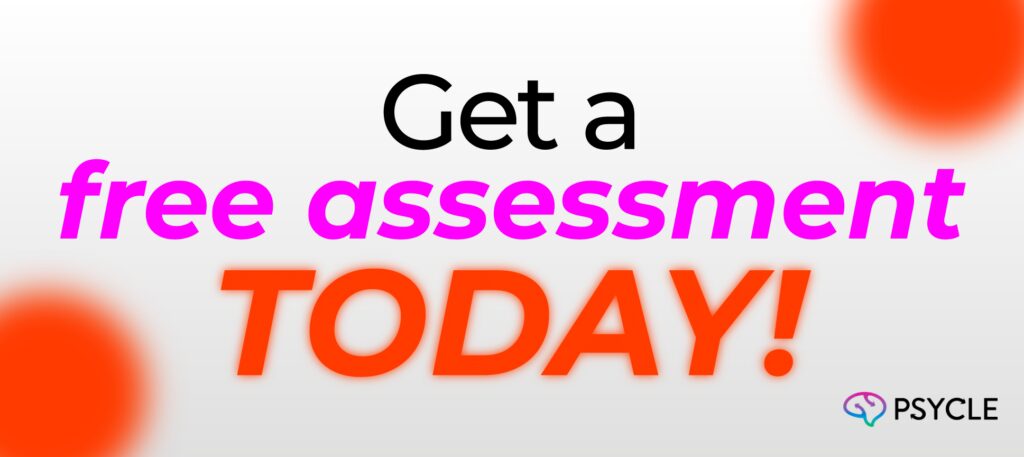

By employing these coping strategies, individuals can take control of their thoughts and reduce the distress and disruption associated with intrusive thoughts.
Disorders Associated with Intrusive and Impulsive Thoughts
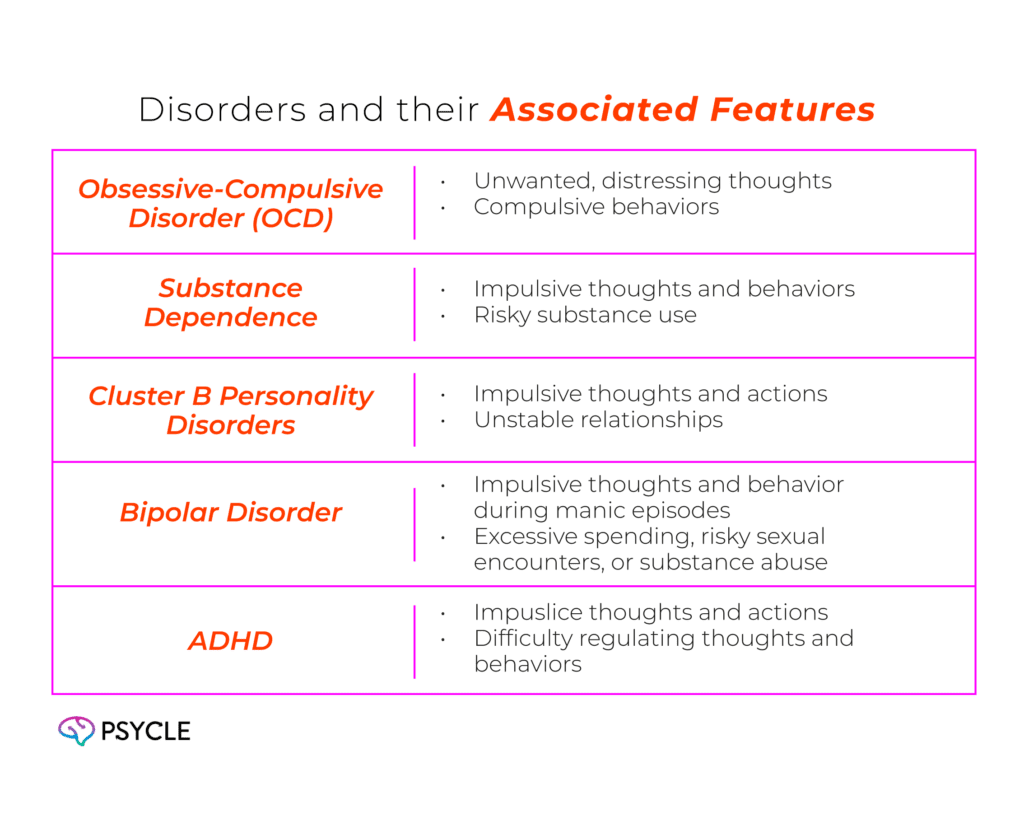

Individuals experiencing intrusive thoughts are often diagnosed with obsessive-compulsive disorder (OCD). These unwanted, distressing thoughts are a hallmark symptom of OCD, accompanied by compulsions or repetitive behaviors that individuals engage in to alleviate anxiety.
For instance, a person may have intrusive thoughts about harming themselves or others and subsequently feel compelled to perform rituals or specific actions to alleviate the distress caused by these thoughts.
Conversely, impulsive thoughts are often associated with a range of mental health conditions and behaviors:
- Drug Dependence: Impulsive thoughts and behaviors are commonly observed in individuals struggling with substance abuse and dependence. The impulsivity may contribute to a cycle of substance use and further reinforce addictive behaviors.
- Cluster B Personality Disorders: Conditions such as borderline personality disorder, narcissistic personality disorder, and antisocial personality disorder are characterized by impulsive thoughts and actions. Individuals with these disorders may engage in risky behaviors, have unstable relationships, and struggle with impulse control.
- Bipolar Disorder: During manic episodes, individuals with bipolar disorder may experience impulsive thoughts and engage in impulsive behaviors, such as excessive spending, risky sexual encounters, or substance abuse.
- ADHD: Attention-deficit/hyperactivity disorder (ADHD) is associated with impulsive thoughts and impulsive behaviors. Individuals with ADHD often struggle with impulse control and have difficulty regulating their thoughts and actions.
While these associations provide insights into the relationship between certain mental health disorders and impulsive thoughts, it’s essential to consult with a qualified mental health professional for an accurate diagnosis and appropriate treatment.
Conclusion
Understanding the difference between intrusive and impulsive thoughts is crucial for effectively managing these experiences and seeking appropriate therapy. Intrusive thoughts, characterized by unwanted, disturbing, and persistent thoughts and images, often stem from anxiety and trauma. In contrast, impulsive thoughts are action-oriented and driven by desires and spontaneity.
By recognizing the origins and characteristics of intrusive and impulsive thoughts, individuals can develop coping strategies to navigate them more effectively. Cognitive and behavioral interventions have proven to be particularly successful in managing intrusive thoughts associated with conditions like obsessive-compulsive disorder (OCD). Seeking therapy in these instances can be immensely beneficial.
Similarly, understanding impulsive thoughts and their potential consequences is essential for avoiding risky behaviors and preventing harm. For those experiencing impulsive thoughts related to drug dependence, personality disorders, bipolar disorder, or ADHD, seeking professional help and therapy is crucial for managing and addressing these underlying conditions.
Overall, by gaining a deeper understanding of intrusive and impulsive thoughts, individuals can take proactive steps towards managing their thoughts and seeking therapy when needed.
FAQs
What’s the Difference Between Intrusive and Impulsive Thoughts?
Intrusive thoughts are unwanted, disturbing, and persistent thoughts and images, often associated with anxiety and trauma. Impulsive thoughts, on the other hand, are action-oriented, often pleasurable thoughts and behaviors that stem from desires and spontaneity.
What are the Characteristics of Intrusive and Impulsive Thoughts?
Intrusive thoughts can cause distress and disruption in daily life. Impulsive thoughts, on the other hand, can lead to risky actions and later regret.
How Common are Intrusive and Impulsive Thoughts?
Approximately 94% of people experience intrusive thoughts and images. However, the prevalence of impulsive thoughts is not specified in the provided data.
What are Coping Strategies for Intrusive and Impulsive Thoughts?
Effective cognitive and behavioral interventions can help individuals overcome OCD and manage intrusive thoughts. No specific coping strategies are mentioned for impulsive thoughts, but therapy and self-care techniques may be beneficial.
How do Intrusive and Impulsive Thoughts Impact Daily Life?
Intrusive thoughts can cause individuals to be more upset and disturbed, potentially leading to distress and disruption in daily activities. Impulsive thoughts can lead to dangerous or harmful behaviors, with physical and psychosocial consequences.
What Associated Disorders are Linked to Intrusive and Impulsive Thoughts?
Intrusive thoughts are commonly seen in individuals with obsessive-compulsive disorder (OCD). Impulsive thoughts are associated with drug dependence, cluster B personality disorders, bipolar disorder, and ADHD.

